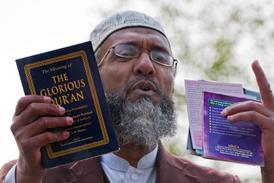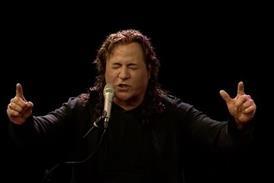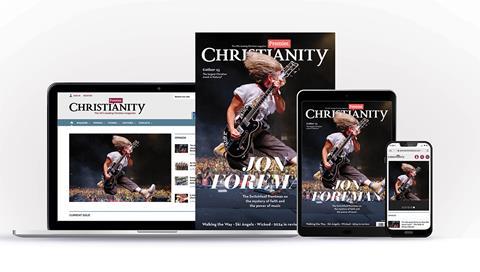Dan Brown’s latest blockbuster The Lost Symbol contends that miracles are the result of mind power, not the work of the Holy Spirit. So how does Brown handle the Bible to back up his claims?
The arrival of a new Dan Brown fictional epic often causes pause for thought among those who profess to believe in biblical Christianity because of the theories that he advances about spiritual reality and particularly about the person of Christ. The Da Vinci Code has sold in excess of 70 million copies worldwide and is probably the biggest selling fiction title of all time. It sought to persuade its readers that Jesus married and had children.
The effect on believers and non believers was profound. Nicky Gumbel, the high profile public face of the Alpha Course, was prompted by the sheer weight of anxious enquiries about The Da Vinci Code to create a special sermon and video to help people understand the factual weakness at the heart of Brown’s analysis. Dan Brown’s new book, The Lost Symbol, seeks to suggest that all of the major religions, including freemasonry, point to a god within and that Jesus was merely a prophet in this tradition, adept at using his own mind to create powerful and seemingly miraculous change, particularly with respect to physical healing.
Langdon, the Harvard professor of the esoteric, is the male hero of The Lost Symbol. He has guided us through two previous Dan Brown novels and introduces us to the mystical significance of the architecture of Washington DC in this fast-paced exploration of the significance of freemasonry. Freemasonry is a worldwide brotherhood that seeks to unite people of different faiths in a belief in the ‘Great Architect of the Universe’. It is highly active throughout the Western world but is viewed with suspicion by many.
Throughout the book, Brown places dialogue in the mouth of Langdon that makes him an apologist for freemasonry: “The difference between Masonic spirituality and organised religion is that the Masons do not impose a specific definition or name on a higher power…this enables Masons of different faiths to gather together…one could say the Masonic tradition of tolerance and open-mindedness is commendable.”
As the book grows in popularity, Christians who take seriously the authority of the Bible will face two challenges. What are we to make of the positive image of freemasonry presented in this widely read book? How can we respond to those who question our understanding of who Jesus was and what he did? Brown’s stories are thinly veiled didactic fiction. (Christian didactic fiction includes Pilgrims Progress, The Narnia Chronicles, The Shack, Left Behind and the works of Frank Perreti). His writing marginalises the Holy Spirit, undermines what we understand about the divinity of Christ and calls into question conventional beliefs about the trinity. Throughout The Lost Symbol Brown uses the Bible selectively and out of context. He also seeks to suggest throughout the text that key Christian rituals and beliefs have been borrowed from other religions.
One of the problems with Brown’s writing is that many non- Christian critics question his use of facts and his quoting of other sources. This is important because he claims at the front of the book that many of the organisations, buildings and rituals that he mentions are real. Space does not permit a lengthy analysis of the faults and errors in The Lost Symbol but the claims above are given substance when we examine Brown’s use of scripture.
He relies on the King James Version and does not examine the verses in the light of the rest of the passage. A leading female character in the story, Katherine Solomon, suggests a method of interpretation that seeks hidden meanings in code words like temple, heaven, Jacob’s ladder and manna. These are thought to refer to the human body rather than the everyday realities that conventional exegesis would point to. When read through this code word ‘grid’, the Bible is supposed to suggest to us that we are gods and simply need to grasp our own potential.
In the everyday conversations of life, at work, in Alpha groups or in the cut and thrust of student debate, it will be Brown’s use of the Bible that will be presented to us for response.
Free thinking
Brown also refers to thinking and writing around what are called ‘the Noetic sciences’ to help remove his storyline from what some might regard as the bizarre and fantastic. He leans heavily on the idea that many of the scientists of the Enlightenment such as Isaac Newton combined a belief in scientific discovery with an interest in a form of rational mysticism and that freemasonry provided a safe haven for them in times of intolerance or persecution.
While some are suspicious of freemasonry because of alleged secrecy and its part in conspiracy theories about world politics, many feel that it is a benign charity with Christian sympathies. How real are the differences between Christianity and freemasonry?
Even before we answer that question one of the problems we face is that freemasonry is very hard to generalise about. Tobias Churton, the leading British academic expert on freemasonry notes in Freemasonry – the Reality that there is a small UK Masonic group which affirms Trinitarian formulas. He also suggests that British freemasonry leans towards biblical pictures and metaphors in its understanding of ritual, whereas much European freemasonry will be of a more esoteric bent.
Outsiders looking in at evangelicalism face a similar challenge. We often share common beliefs about God, Jesus and the Holy Spirit but have widely divergent views about the end times, the nature of human government and the role of the supernatural today. But Christianity and freemasonry remain incompatible despite the fact that they sometimes share common language. There are many reasons for this:
1. An alternative mythology
There will be those within Masonic circles who strongly believe in an alternative history centred around the character of Hiram Abiff, a noted figure in the building of Solomon’s Temple. Churton also notes that alternative mythologies not found in the Bible with respect to Seth, Noah and Solomon are also part of the Masonic lore. The more extreme views from within this mythology suggest that Jesus was merely a king in the dynastic line of David and that his offspring helped seed the royal families of Europe, who in their view rule by divine right.
2. An alternative salvation
At the heart of the Masonic worldview is a quest for wisdom about how to live life. The key English Masonic lodges removed references to Jesus from their ritual more than 200 years ago.
There is no significant role within this for Christ’s work at the cross nor for Christ’s claims to be “the way the truth and the life” (John 14:6) and the apostles’ claim that he was the sole mediator between God and man (1 Timothy 2:5). If many religions are valid – a central tenet of the Masonic ideal – then the truth claims of orthodox Christianity are put aside and the Bible reduced to a moralistic handbook.
Part of the ritual of acceptance for a new Mason talks of having ‘long been in darkness’ and being brought to the light. It would be hard for a born again Christian to take such a vow given that Jesus tells us in John 8:12, “I am the light of the world. Whoever follows me will never walk in darkness, but will have the light of life.”
3. An alternative power
If Brown is correct in his depiction of the scientific mystics who helped establish freemasonry as an organised religion, then there is little role for the person of the Holy Spirit. If what we regard as the miraculous is merely the result of mind power then there is no need for God to fill us with the Holy Spirit as the New Testament suggests.
4. An alternative god
Some of the Christian literature on freemasonry purports to show how it involves the worship of occult entities from Canaanite religions and the like. This is not the place to debate the nature of those claims. But at the very least, the god of freemasonry is a deist god and the Trinitarian God at the heart of orthodox Christian belief is set aside.
The ideas in Brown’s book are by no means new. Man as a little god is part of Mormon theology and the preaching of some prosperity teachers. It lurks in the background of teaching about a ‘fourth dimension’.
Knowing how the created relate to the creator will be more important than ever as we respond to the massive propagation of these ideas through the bestselling The Lost Symbol. They also feature highly in the 70 million selling Twilight Saga series. This series of four teenage romance novels has replaced Harry Potter as the must buy book for teenagers in 38 countries. The readers are invited to believe that the heroine Bella wins the day in an epic battle by the awakening of her latent psychic abilities.
The apostle Paul went to Mars Hill to debate with the religious seekers of his day. He often went to the marketplace and engaged in debate. As The Lost Symbol leaks its ideas into the thinking of millions over the coming weeks and months we will want to remind ourselves what it is that we believe about the person of Jesus and the work of the Holy Spirit. We will want to understand how being made in the image of God equips us to emulate him but not to possess godlike powers.
We will want to marinate our minds in truth so that we might graciously respond when we to find ourselves with the seekers of our day.
Brown and the Bible
A guide to responding to out-of-context quoting of Bible texts
‘The kingdom of God is within you’
Brown has a character suggest that because we are created in the image of God, we are not inferior to him. He quotes Luke 17:21 to bolster his case.
Many translations do not use the word ‘within’, preferring ‘among’, ‘in your midst’ or ‘within your grasp’. New Testament theologian TW Manson notes that the word ‘within’ makes sense of the Greek word ‘entos’ but that the original Aramaic word often translated as ‘entos’ could just as easily have been translated into Greek words meaning among or ‘in your midst’. He favours this translation given that Jesus is talking to the Pharisees and is unlikely to be saying that the kingdom of God is within them. He was more likely to suggest that it was ‘in their midst’ because he was making the kingdom explicit by healings, exorcism and authoritative teaching. So, not a good verse to build a theology of innate divinity on.
‘Ye are gods’
Langdon is processing some information and says to himself: “This persistent message of man’s own divinity – of his hidden potential – was the recurring theme in the ancient texts of countless traditions. Even the Holy Bible cried out in Psalm 82:6: ‘Ye are gods’.”
CH Spurgeon suggests that the poet of the temple, Asaph, is using his imagination in this psalm to imagine a gathering of judges and rulers who will be admonished for their failure to extend justice. Although they are given a title which suggests a delegated authority from God, their essential humanity is reinforced by the warning that they will die like men. Even interpretations that move away from understanding the word used for ‘gods’ to be interchangeable with that for ‘judges’, still interpret this psalm as an address to angelic principalities and powers who are failing to act justly on God’s behalf. Brown cannot construct a theology of human divinity on three words wrenched out of context.
‘Nothing is hidden that will not be revealed’
The dean of Washington Cathedral is arguing over Revelation symbolism with Langdon and suggests that even the Bible supports the idea of a transformative moment of enlightenment. He quotes Jesus from Luke 8:17. Langdon repeats the quote to himself as he ponders how our ideas of God are actually just symbols of our limitless human potential.
Jesus is further expanding on the Parable of the Sower and the idea of good fruit or a good harvest. The message of the gospel comes like a light, it illuminates the thoughts and intentions of men’s hearts. The reader is urged to take God’s word to heart and act upon it, because it carries some responsibility, once you have heard it. It is a major intellectual leap to believe that in the middle of a passage about how the word of God must be nurtured, treasured and valued, Jesus would start prophesying about a future enlightenment when the drift of the passage is suggesting that God will reveal the state of our heart now.
‘Unto you is given to know the mystery... but it will be told in parables’
In a page full of partial quotes, Langdon and Peter Solomon exchange scripture verses that would seem to suggest that there has always been a hidden, esoteric strand within the teachings of the Bible. The quote above is from Mark 4:11.
Jesus clearly teaches that his parables will either really help people understand the truth or obscure it for them. He constantly used questions and parables to provoke people to think about what being in the kingdom meant. People came to follow him with all different types of expectation. Would he be the warrior king? Would he be the healing prophet with commands for his followers? He was neither and hinted that those who had a heart that was really prepared to embrace the kingdom of God would wrestle with his sayings and be transformed by them.
While some of his parables were hard to understand according to his disciples, others were blatantly clear and would have evoked an emotional response within the listeners – the Prodigal Son and the Good Samaritan for instance.
The Coffman Commentary reflects on this passage:
“Nowhere in the New Testament does this term (mystery) correspond to esoteric knowledge and rites as in the so-called mystery religions of the Roman Empire.”
‘Mystery’ in the New Testament sense refers to a glorious truth long concealed but now revealed (Romans 16:25,26). Cranfield described the mystery as the fact “that the kingdom of God has come in the person, words, and works of Jesus.”
‘The eye is the lamp of the body. If your eyes are good, your whole body will be full of light’
Katherine Solomon is trying to make the case that some of the religions of the world point to a common truth that can be unlocked with the right esoteric code. She suggests that the pineal gland represents the all-seeing eye of God and then quotes Matthew 6:22 as well as symbolism from New Age and Hindu thought.
Ancient Mediterranean thought sometimes viewed light as something that emanated from you, like a searchlight. If your heart was corrupt then you would be in darkness. If your heart was good it would colour how you saw things. However Jesus is playing with the language here, in the context it is a reflection on who you serve. Where is your treasure being laid up? Are you trying to serve two masters – God and wealth? Are you being seduced by the lust of the eye?
You cannot interpret this verse as an esoteric hint when it’s plainly about the everyday conduct of our lives and our attitude towards material possession.
How should Christians respond to Dan Brown's new novel The Lost Symbol? Dave Roberts talks to Justin Brierley on Premier.TV



























